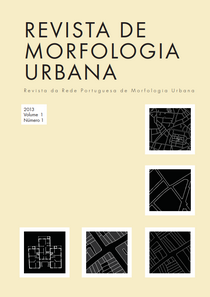Abstract
This paper describes the origins, development and characteristics of the school of urban morphological thought that is grounded in the work of M. R. G. Conzen. After considering the early influences of Schlüter and Geisler, attention is given to the concepts Conzen developed, such as the burgage cycle, the fringe belt, the morphological frame and the morphological region. In the second half of the paper three examples of current research that builds on foundations laid by Conzen are illustrated: namely, micromorphology, the relationship between morphological periods and the typological process, and the link between decision-taking and urban form.
References
Conzen, M. R. G. (1932) Die Havelstädte, unpublished Staatsexamen dissertation, Universidade de Berlim, Alemanha.
Conzen, M. R. G. (1958) ‘The growth and character of Whitby’, em Daysh, G. H. J. (ed.) A survey of Whitby and the surrounding area (Shakespeare Head Press, Eton), 49-89.
Conzen, M. R. G. (1960) Alnwick, Northumberland: a study in town-plan analysis Institute of British Geographers Publication 27 (George Philip, Londres).
Conzen, M. R. G. (1962) ‘The plan analysis of an English city centre’, em Norborg, K. (ed.) Proceedings of the IGU symposium in urban geography Lund 1960 (Gleerup, Lund), 383-414.
Conzen, M. R. G. (1988) ‘Morphogenesis, morphological regions and secular human agency in the historic townscape, as exemplified by Ludlow’, em Denecke, D. e Shaw, G. (eds.) Urban historical geography (Cambridge University Press, Cambridge), 255-61.
Fritz, J. (1894) ‘Deutsche Stadtanlangen’, Beilage zum Programm 520 des Lyzeums Strassburg (Strassburg).
Geisler, W. (1918) Danzig: ein siedlungsgeographischer Versuch (Kafemann, Danzig).
Louis, H. (1936) ‘Die geographische Gliederung von Gross-Berlin’, em Louis, H. e Panzer, W. (eds.) Landerkundliche Forschung: Krebs-Festschrift (Engelhorn, Estugarda), 146-71.
Maffei, G. L. e Whitehand, J. W. R. (2001) ‘Diffusing Caniggian ideas’, Urban Morphology 5, 47-8.
Schlüter, O. (1899a) ‘Uber den Grundriss der Städte’, Zeitschrift der Gesellschaft für Erdkunde zu Berlin 34, 446-62.
Schlüter, O. (1899b) ‘Bemerkungen zur Siedlungsgeographie’, Geographische Zeitschrift 5, 65-84.
Slater, T. R. (1990) ‘English medieval new towns with composite plans’, em Slater, T. R. (ed.)
The built form of Western cities (Leicester University Press, Leicester), 71-4.
Whitehand, J. W. R. (1977) ‘The basis for an historico-geographical theory of urban form’, Transactions of the Institute of British Geographers, NS2, 400-16.
Whitehand, J. W. R. (1988) ‘Urban fringe belts: development of an idea’, Planning Perspectives 3, 47-58.
Whitehand, J. W. R. (2001) ‘Changing suburban landscapes at the microscale’, Tijdschrift voor economische en sociale geografie 92, 171–7.
Whitehand, J. W. R., Morton, N. J. e Carr, C. M. H. (1999) ‘Urban morphogenesis at the microscale: how houses change’, Environment and Planning B: Planning and Design 26, 503-15.
Os direitos autorais permanecem com os autores, que autorizam a Revista de Morfologia Urbana a publicar o artigo sob uma licença Creative Commons Atribuição (CC-By).


